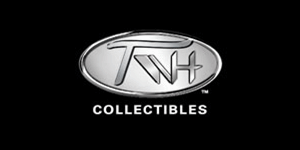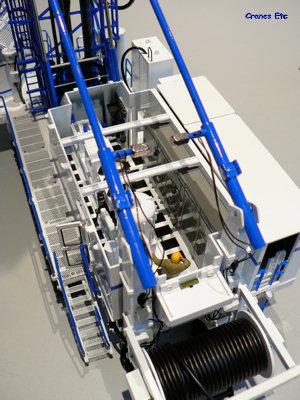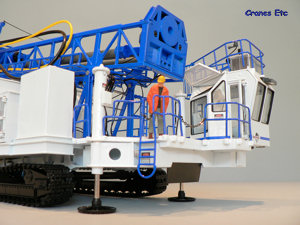 |
| Bucyrus box. |
 |
 |
| All the parts out of the
box. |
 |
| Stairs which can lift and
lower, and an opening door. |
|
|
 |
| With the roof off, there
is plenty of interior detail. |
 |
| The end of a drill rod
with detailed cutting head. |
 |
| Ready to raise the mast.
|
 |
| The drilling platform.
There is an opening debris guard to provide visibility from the
cab. |
 |
| The mast can be set for
angled drilling. |
 |
| Close up of the drill motors.
|
|
The Bucyrus 49HR is a hard rock drilling rig
used in opencast mines for rotary drilling holes which are later
packed with charges and fired to break up the rock and enable easier
excavation by shovels and draglines. The 49HR can drill holes
up to around 400mm (16in) diameter which can be angled by up to
25° and the mast height is typically nearly 20m (65ft). The
drill motor is fixed to a trolley which travels up and down the
mast using a rack and pinion system. This design allows constant
pressure to the drill head when drilling.
The model has been produced in a variety of different colour schemes
and this version is white with a blue mast.
Packaging
The picture box is fairly large and the model is contained within
a pair of expanded polystyrene trays. Judging from the condition
of the outer plain box it was clear that it had been subject to
some rough handling in the post and as a consequence there were
a few loose pieces inside the box when opened. These were
easily refixed in position. One of the track links was broken
and a new set of tracks was promptly provided by TWH.
Included in the box is a small 20 page booklet which gives information
about the 49HR and also the Bucyrus company. A double sided
instruction leaflet is provided and it is very good, with clear
photos and a listing of parts. A useful plastic pick tool
makes it easy to open the various doors on the model without needing
long fingernails.
Detail
The metal tracks are very good and finely detailed and this level
of detail continues to the track frames which have rivets and electrical
wiring from the sprockets. There are four stabilisers and
these have large pads on the end of realistic hydraulic pistons.
At the front of the body is the operator's cab and this is highly
detailed with very good graphics on the outside. Inside there
is an excellent console arrangement with detailed screens, equipment
and operator's seat. Outside the cab is a ladder leading to
the cab roof where there is a number of spotlights and a fine air
conditioning unit. The high quality handrails also have a
siren attached completed with wiring leading into the cab.
The work platform area is surrounded by convincing handrails and
chains, and fine mesh walkways, and there is a drain cover at the
foot of the mast. The front stabilisers have control boxes
with wiring, and hydraulic lines. Following the walkway to
the rear leads past a detailed door and warning notices to a set
of stairs which has excellent mesh treads.
At the rear there is a large cable drum complete with realistic
thick feeder cable. There is also fine electrical wiring leading
to the automatic pinning system on the mast stays. A short
ladder leads into the open entry to the radiator room which has
a large cooling fan inside. Moving along the side opposite
the operator's cab there is a large fine mesh screen at the main
radiator and further towards the front a number of opening doors
reveal equipment and a another radiator.
Inside the main body there is a detailed motor and some excellent
electrical switchboard equipment, and the floor has some non-slip
panels.
The mast is a very good heavy lattice construction which includes
toothed racks for the drilling equipment drive, and a ladder which
is complete with safety cage. At the base there is a plethora
of wiring and hoses which drive the winch and lead up to the drilling
motors. The drilling machinery is very detailed with motors
to drive the drill rods and the pinion drive that pushes the drill
down.
The model is completed with some metal drill rods which have finely
detailed drilling heads at the end.
Features
The crawler tracks are free rolling and are mounted on spring loaded
sprockets so it is easy to remove the tracks if required.
The stabilisers work, but are not the usual screw variety found
on other models. Instead they are mini pistons which can be
extended and retracted and are stiff enough to hold a set position.
These look much more realistic than screw jacks.
There are a number of opening doors on the model to the cab, the
engine room and equipment cabinets. Within the radiator room
is a large cooling fan and this actually turns. The roof of
the model has three removable panels and when these are taken off
the very detailed interior is revealed. At the rear of the
walkway the stairs can be set in either a raised or lowered position.
On the back of the machine the main electric cable drum turns and
there is a working cable guide which slides on a rail as the cable
comes off the drum.
The mast can be set in the travelling position, and vertical for
drilling. It is also possible to set it an angle to replicate
the angle drilling function of the real machine although the drilling
platform has not been modelled to allow the drill rod to pass through
at an angle. The drill motor sits on a frame which travels
up and down the racks on the mast and is moved by using two supplied
keys. The mechanism is fairly stiff so there is no problem
setting the drill motor at any desired height.
There is a small winch which is operated by a long key. The
hook modelled is very small and unfortunately it therefore does
not have enough weight to keep tension on the winch string so it
does not hang realistically.
Two drill rods are provided, one short and one long, so it is possible
to pose the model drilling with either.
Quality
The paintwork and graphics are very good, and the quality of the
modelling is very good too. There is hardly any plastic used at all.
It is pleasing to see good quality instructions although this is
slightly offset by concern that the packaging was not able to fully
protect the model during transport.
Price
This is a fairly unique model and does not have any easy comparison
with other models. It is not cheap and this is a reflection
of its size and the detail provided.
Overall
This is a very good addition to the mining sector where previous
models have often focussed on prime movers and excavators, and Bucyrus
are to be commended for commissioning the 49HR. It looks impressive
and the removable roof provides interest when showing off the model.
Overall it is a great model.
Footnotes
The model was first announced at the Nuremberg Toy Fair in 2007.
The following versions were produced: Bucyrus corporate colours
- 1800 models; blue with white mast - 300; white with blue mast
- 300; white with red mast - 300; orange - 300. It was marketed
outside the Americas by NZG as model number 687.
|
|
|
|
 |
| Inside the box. |
 |
| The Bucyrus 49HR |
 |
| The mast folded for transport.
|
 |
| Very detailed cab interior.
|
 |
| Detailed electrical equipment. |
|
|
 |
| Hydraulic rams lowered.
|
 |
| Very detailed tracks and
frames. |
 |
| Power cable drum with working
cable guide. |
 |
| Plenty of opening doors
to allow access for maintenance. Here the
Elliot Fuel and Lube Truck assists. |
 |
| The rig setting up to drill.
|
|

